Posts: 3,730
Threads: 44
Joined: Dec 2008
Model Railroader needs to do a cover story and photo shoot of your layout Wayne!
Mike
Sent from my pocket calculator using two tin cans and a string
Posts: 5,859
Threads: 175
Joined: Dec 2008
Thanks, Mike, but I doubt very much that they'd be interested, and I know for sure that I wouldn't. There's too many unfinished- and nowhere near-finished areas on the layout.
I don't mind showing pictures of partially finished areas if they can help answer questions for other modellers, but a full layout tour should show an at least mostly-finished product.
Wayne
Posts: 77
Threads: 5
Joined: Jan 2009
Wayne,
I never cease to be amazed at your pics. For your mortar, do you dry brush? Wipe a rag across? Chalk? I have done the chalk and dry brush method to varying degrees of success... I like the chalk method, but then when I go to spray a clear coat to fix it, even on low pressure, my airbrush blows a lot of it off. I am new to airbrushing though. The dry brush method does a pretty good job but again I sometimes get a bit enthusiastic with my removal and take more than I wanted. I keep at it though. One day I hope to be at the very least proficient.
We are building a shop (woohoo!) with mother in law quarters (boo! just kidding) built in... I am hoping to use some of that shop space for a new layout.
George
Posts: 5,859
Threads: 175
Joined: Dec 2008
Good to hear from you, George.
I use pre-mixed drywall mud for the mortar effect. A small tub of it goes a long way. I use a rag over my fingertip(s), dip into the mud and spread it over the brickwork. It is a bit of a nuisance if there's projecting details, especially on the fronts of many of those DPM structures, which often make it difficult to get the mud on the brick areas without getting it all over the places that don't need mortar, such as the faux iron-front details that were all the vogue from the mid-eighteen hundreds, and well into the 20th century.
However, once the mud dries, the excess is removed from the brick, using a clean rag over your fingertips...if possible, work outdoors, so that you can periodically shake-out the cloth (stand up-wind when doing this).
To clean the excess mud off those bulky details, I use a couple of X-Acto knives, one a regular #11, and a couple of chisel-type blades, to gently scrape away the stuff that shouldn't be there.
Once the mortar is in the brick detail, and removed from the areas where it shouldn't be, the non-brick areas can be painted. In most cases I prefer to use a brush, as it usually eliminates the need for masking.
Before installing window "glass", I've lately decided to airbrush Dullcote over at least all of the areas where there's brick, but it won't hurt to do the non-brick areas, too.
The reason for the Dullcote is mostly to prevent water-based weathering washes from removing the "mortar".
If you use chalk or oil-based pastels for weathering, the Dullcote probably isn't necessary. I'm not sure about weathering with India ink...I've had no problems with it when thinned with water, but using alcohol as a thinner (which can also be a paint remover) may require some caution.
(10-04-2021, 08:44 PM)deckroid Wrote: ...I like the chalk method, but then when I go to spray a clear coat to fix it, even on low pressure, my airbrush blows a lot of it off.....
When the drywall mud has been applied to the areas of brick, and has dried, the excess can be rubbed-off quite vigorously without removing it from the places where it's supposed to be.
Wayne
Posts: 5,859
Threads: 175
Joined: Dec 2008
A few minutes ago, (around 1:00AM) I applied pre-mixed drywall compound to another DPM structure, deliberately overdoing the amount used, in order to show how some areas, which have no need for mortar effects, get mortar effects anyway.
The kit is not painted, but was moulded in two colours. I applied the mortar to the dark red plastic, while the mortar on the black portion of the front got there by carelessness. The mortar on the upper portion of the front wall was also applied more generously than was needed...
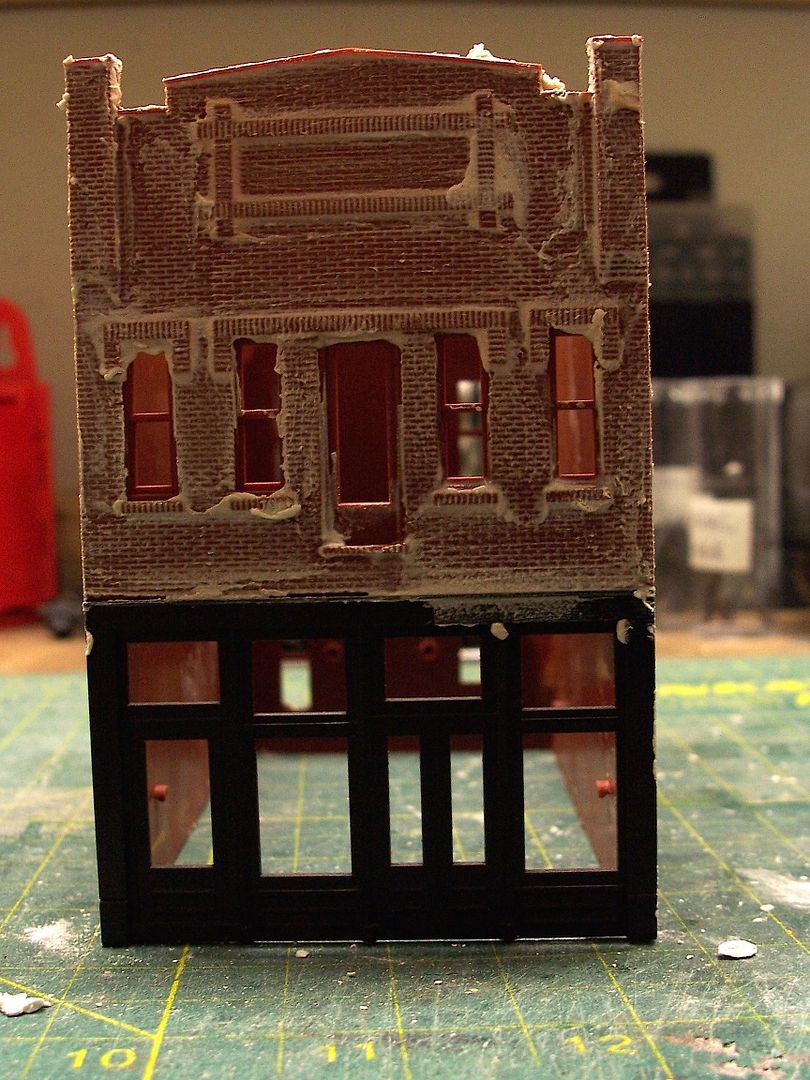
There's not much detail on the rear of the structure, other than three windows and a door, but I deliberately used too much mud there too, mainly to show how the excess can be fairly easily removed after it has dried...
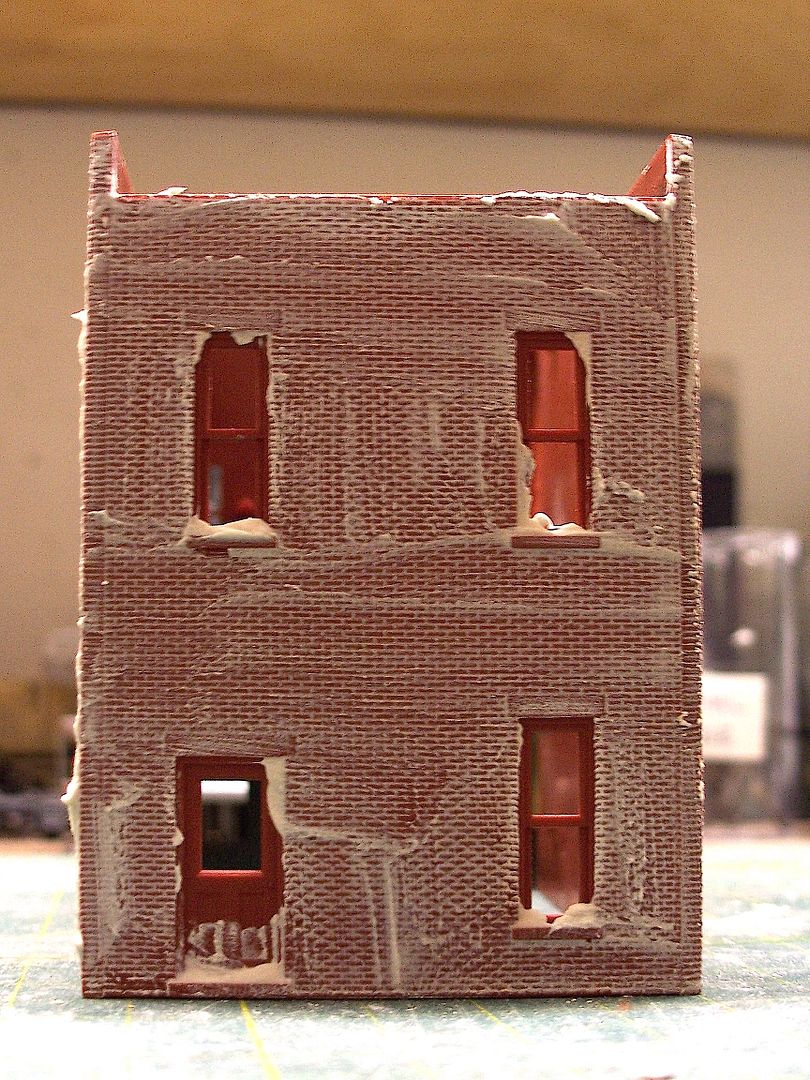
The two side walls have no detail other than the moulded-in brick pattern, so those sides will be easily clean by rubbing with a clean rag....
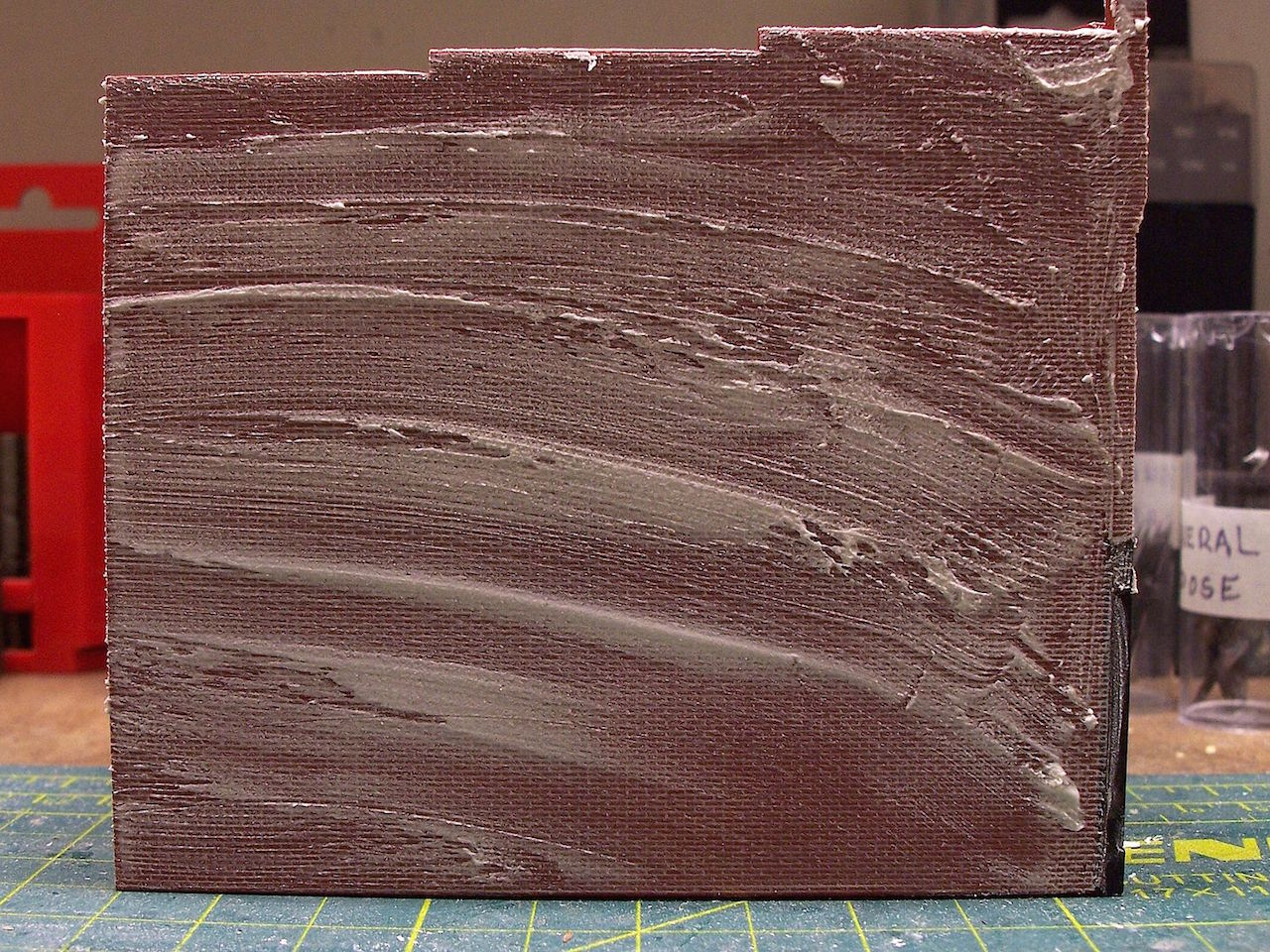
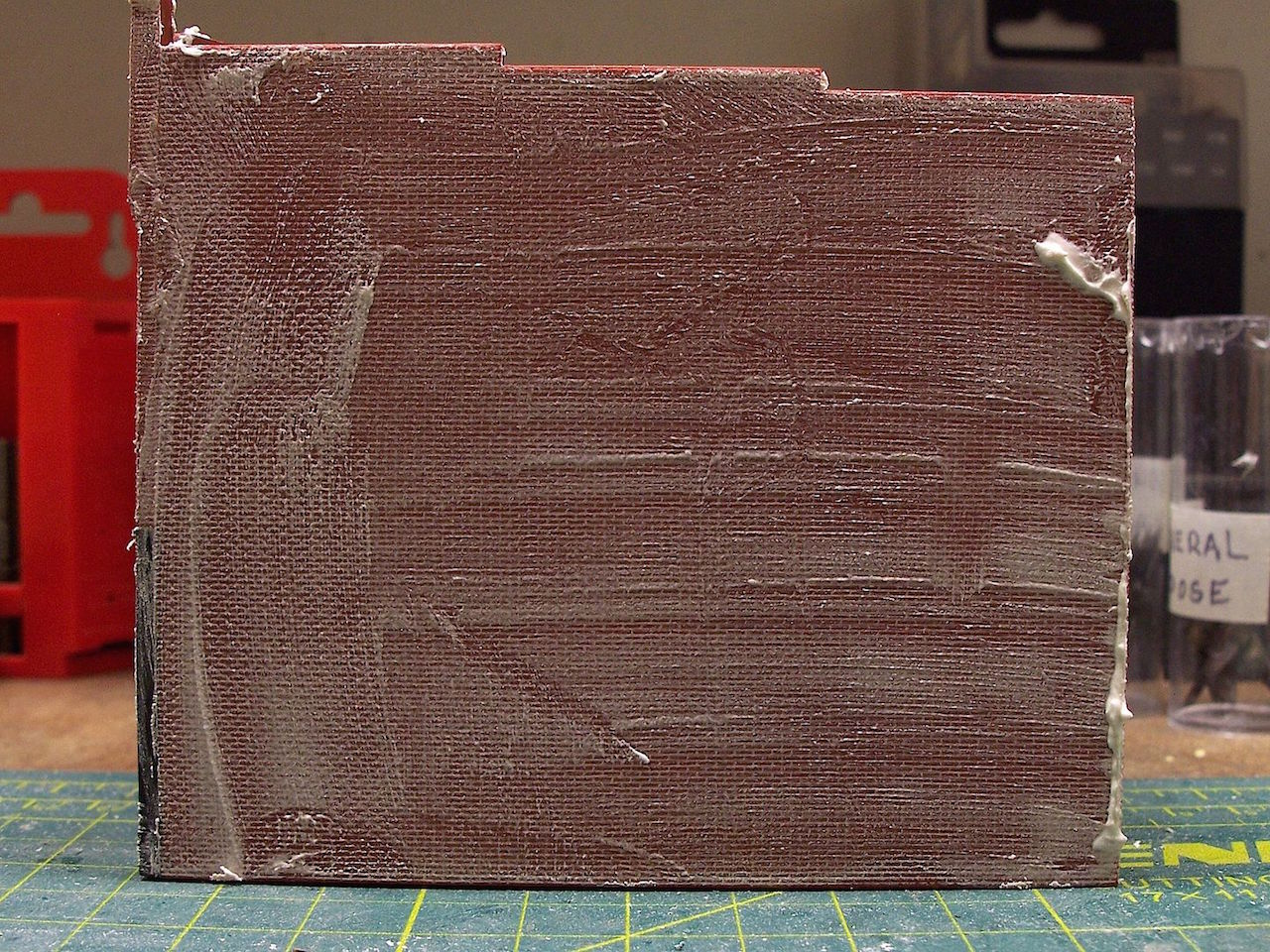
I'll let the structure dry overnight, but probably won't get around to cleaning it until tonight.
Wayne
Posts: 11,747
Threads: 571
Joined: Nov 2008
You have me sold at this point. I've tried other methods and they don't usually turn out as good as I'd like, even after many re-dos. I always keep a bucket of joint compound handy for my scenery work, got two DPM kits that I'm going to do the mortar this way....  
Don (ezdays) Day
Board administrator and
founder of the CANYON STATE RAILROAD
Posts: 77
Threads: 5
Joined: Jan 2009
Looks like I'm going to have to hit the hardware store on my way home! I wonder if my local store sells GERN drywall compound... I hear it's 3% smoother than leading brands.
Posts: 5,859
Threads: 175
Joined: Dec 2008
(10-06-2021, 09:04 AM)deckroid Wrote: Looks like I'm going to have to hit the hardware store on my way home! I wonder if my local store sells GERN drywall compound... I hear it's 3% smoother than leading brands.
You got it, pal...that's the flux molecules in action!   
I finally got around to cleaning up that over-mortared DPM structure, but I'm not overly pleased with the results. After rubbing off the excess mortar where there was only brick detail, the mortar was removed in a couple of areas....it may have been applied a little too wet. I re-did those areas, but lost some mortar again, as you'll see in the photos showing clean-up where the drywall mud gets removed from non-brick areas. I wonder if perhaps some areas of the moulded-in grooves, which represent the areas where mortar would be, are too shallow...I'll see if I can address that later.
As mentioned previously, I use X-Acto knives to remove excess mortar from around door and window details, or where there is detail representing materials where mortar wouldn't be used. If such details are near those areas of brick, it's difficult to not get mortar where it's not required.
While the pointy #11 blade is useful for getting into tight confines, I prefer the #17 chisel-type blade...

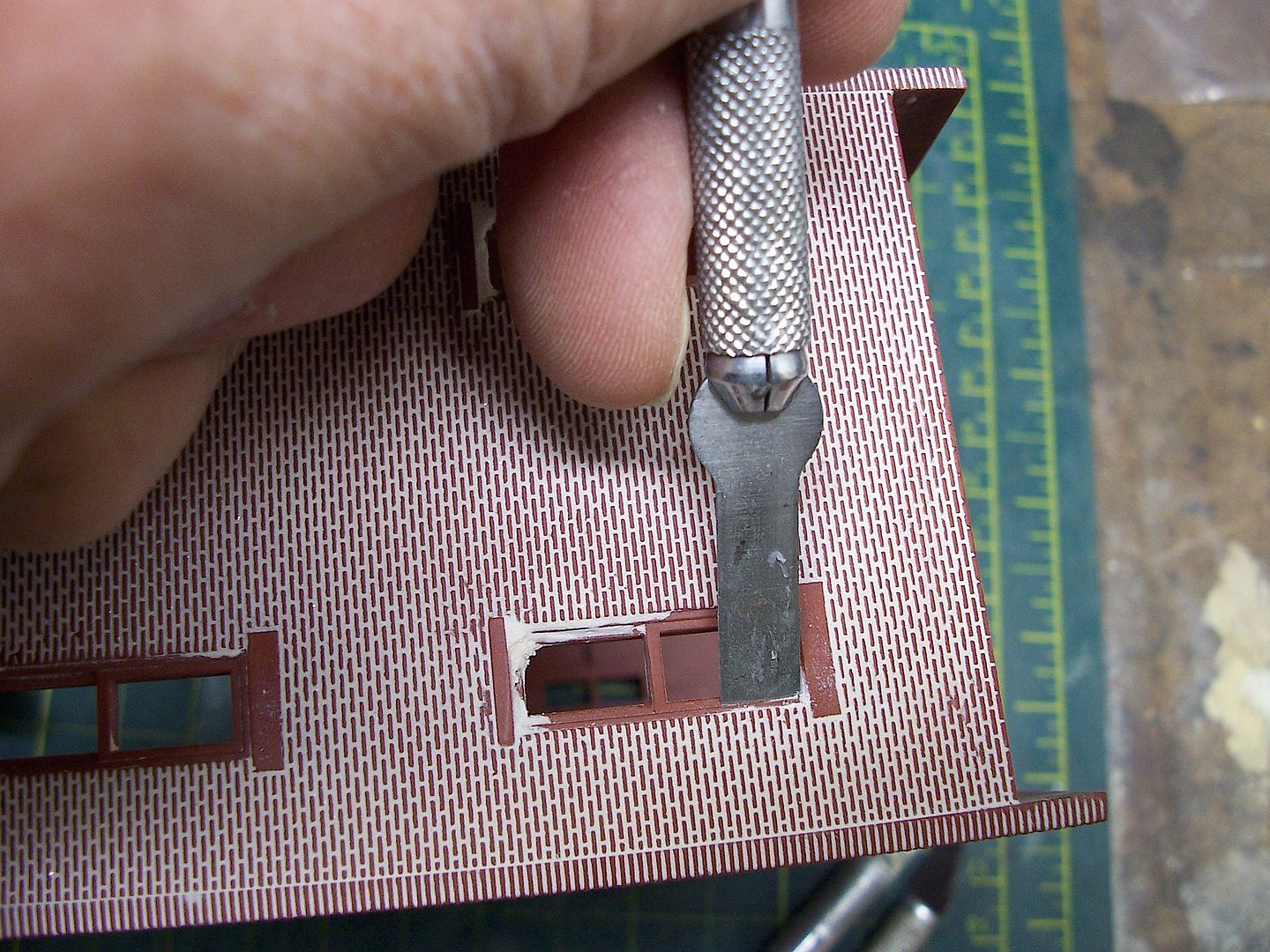

...and for hard to access areas, the #17 blade can be altered with careful use of a cut-off disc in a motor tool...

This side wall, with no detail other than bricks, was worked-over with only a dry cloth...

The back wall, however, lost some mortar
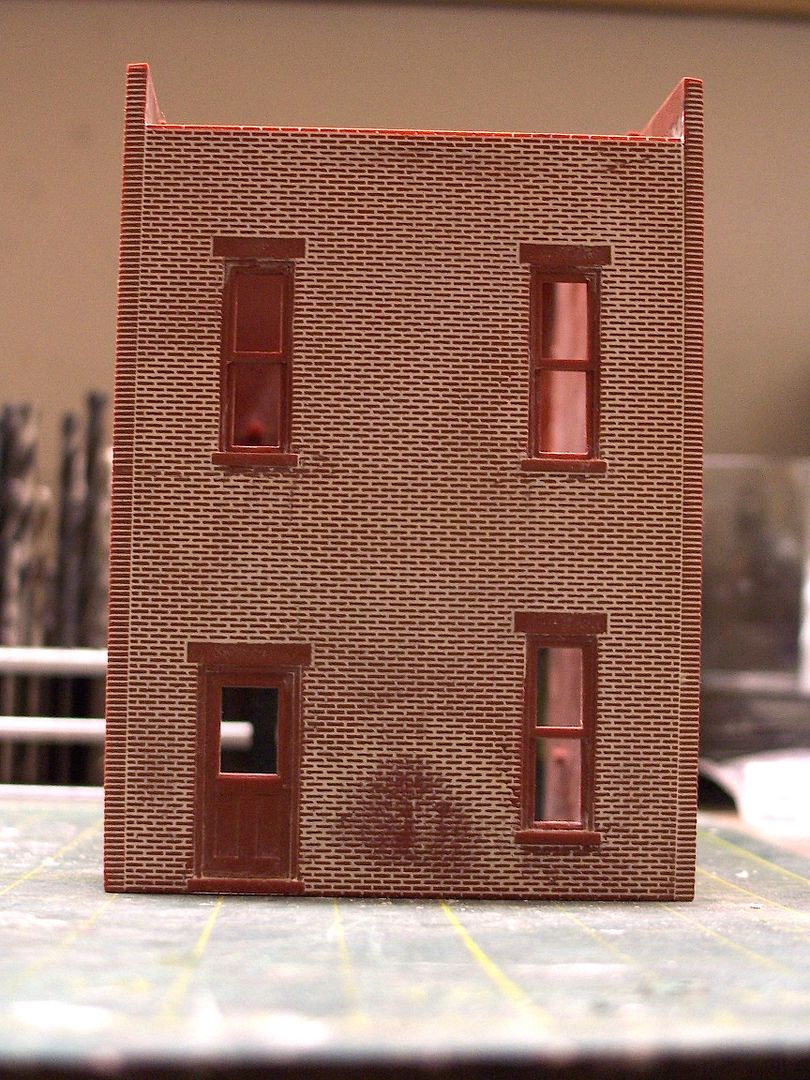
...as did portions of the front....

The other side wall also lost a small area of mortar. I re-applied the drywall mud to those areas, but got the same results. I'll see if I can come up with a fix.
Posts: 11,747
Threads: 571
Joined: Nov 2008
Could be a bit of oil or it's a bit too slick in those areas. Let us know what you find. I'm going to try your method, but put everything in the ultrasonic cleaner before I do anything.
Don (ezdays) Day
Board administrator and
founder of the CANYON STATE RAILROAD
Posts: 1,060
Threads: 111
Joined: Jan 2009
10-07-2021, 11:49 AM
(This post was last modified: 10-07-2021, 11:58 AM by jim currie.)
Wayne I've had the same thing happen i finally traced it down to spots i touched after washing (aka finger oil )
jim
PS i don't know if you have found this or not . Brick Windows Arches & Details - HO | Quality & Innovation Since 1991 (thenarch.com)
Posts: 2,409
Threads: 63
Joined: Dec 2008
Wayne:
Lee Valley sell plastic razor blades which I use where a steel knife might damage the surface. I bet they could be cut down to the size required.
David
Moderato ma non troppo
Perth & Exeter Railway Company
Esquesing & Chinguacousy Radial Railway
In model railroading, there are between six and two hundred ways of performing a given task.
Most modellers can get two of them to work.
Posts: 5,859
Threads: 175
Joined: Dec 2008
(10-07-2021, 11:49 AM)jim currie Wrote: Wayne I've had the same thing happen i finally traced it down to spots i touched after washing (aka finger oil )
jim
I think that you're right, Jim. I usually wash the assembled larger components in preparation for painting the brick, but that last one likely wasn't washed, as I hadn't planned on painting it.
I'll remove the mortar that's there, then toss it into some soapy warm water, give it a good rinse, then let it air-dry.
I have another 3 or 4 DPM structures that have their bricks painted, but are still needing mortar.
I also have some used and poorly assemble DPM kits and parts, which I hope to make into something useful...perhaps an addition to the Atlas kit for Middlesex Manufacturing. When the partially assembled DPM kits have all been partially painted and mortar-fied, I'll be setting them aside so that I can get back to working on the baggage and head-end cars, which were the original subject of this thread.
(10-07-2021, 07:24 PM)BR60103 Wrote: Wayne:
Lee Valley sell plastic razor blades which I use where a steel knife might damage the surface. I bet they could be cut down to the size required.
Wow, that's a new one...I wonder what kind of a shave they'd do. I don't have much problem with the X-Acto blades, but I always use my Optivisor when doing such work...without it, I might not only damage the item, but likely myself, too.
I'm constantly re-sharpening my X-Acto blades, and the only time I use a new one is when cutting-out decals.
Wayne
Posts: 2,409
Threads: 63
Joined: Dec 2008
David
Moderato ma non troppo
Perth & Exeter Railway Company
Esquesing & Chinguacousy Radial Railway
In model railroading, there are between six and two hundred ways of performing a given task.
Most modellers can get two of them to work.
Posts: 1,060
Threads: 111
Joined: Jan 2009
I'll remove the mortar that's there, then toss it into some soapy warm water, give it a good rinse, then let it air-dry.
I have another 3 or 4 DPM structures that have their bricks painted, but are still needing mortar.
Wayne i found that even painter surfaces can hold traces of finger oil hence i wash even the painted brick surfaces .
jim
Posts: 5,859
Threads: 175
Joined: Dec 2008
Maybe I'll have to return to wearing nitrile gloves (as I do when airbrushing) when handling these structures. Given the current need for frequent hand-washing, mine are often so dry that it's difficult to even pick up a piece of paper.
While I have cleaned off the mortar (using a small wire brush with stainless steel bristles) and have re-washed the structure, not much else has been accomplished, as a couple of the grandkids have been here for a sleepover, which usually means not much sleep, but lots of noise and foolin' around and playtime.
Wayne
|



![[Image: np_F-1ani.gif]](http://i222.photobucket.com/albums/dd21/deckroid/np_F-1ani.gif)
![[Image: goog.gif]](http://i222.photobucket.com/albums/dd21/deckroid/goog.gif)


